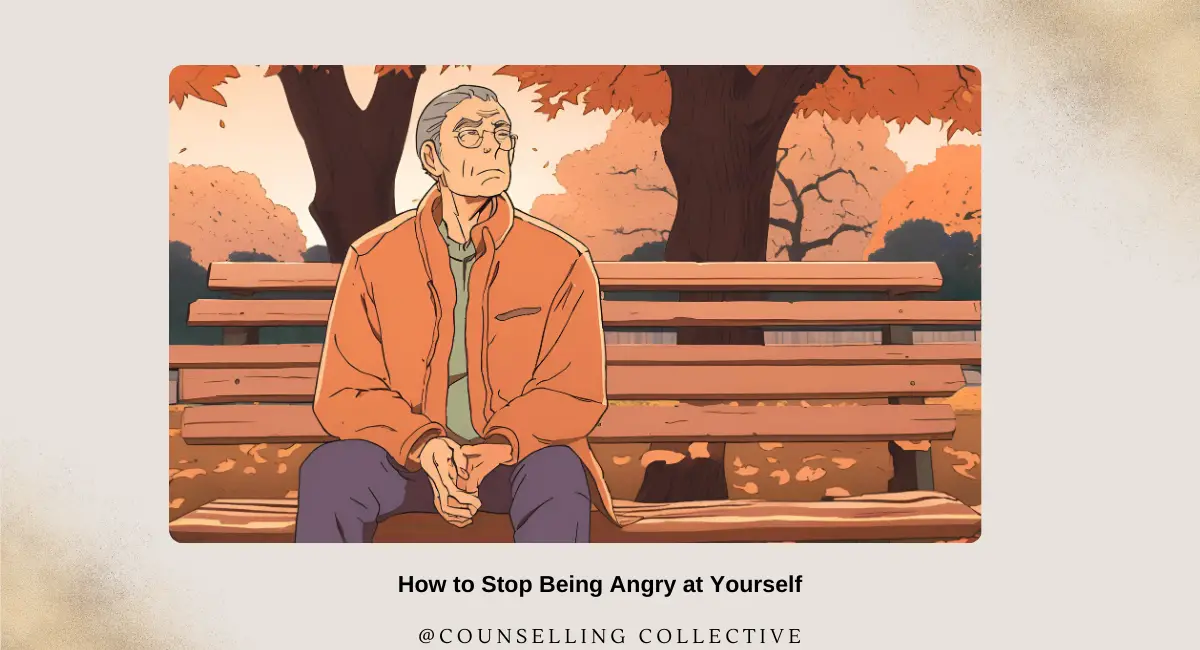
It’s understandable to feel angry at yourself when you perceive you’ve made mistakes or fallen short. Many people experience this, and you’re not alone. When disappointment turns inward, it can become a painful cycle of self-blame that impacts your confidence and well-being. This guide will explore several evidence-based techniques, including Cognitive Behavioral Therapy, Compassion-Focused Therapy, and Acceptance and Commitment Therapy, to help you break free from the cycle of self-anger and move towards self-acceptance and peace.
Do following questions seem familiar to you:
- “Why do I keep getting so angry at myself over small things?”
- “Am I a bad person for feeling this way?”
- “How can I stop beating myself up over past decisions and just move on?”
If you resonate with any of them then let’s explore compassionate, science-backed strategies to help you heal. Want quick free resource before your read further? Here you go!!
What Does It Mean to Be Angry at Yourself?
Self-directed anger is when you turn frustration, blame, or criticism inward. It might sound like: “Why did I do that? I’m so stupid.” “I always mess things up.” “I’ll never be good enough.”
Unlike anger toward others, this stays inside, eroding your self-esteem and often stemming from unmet expectations, guilt, perfectionism, or past trauma.
Left unaddressed, it can lead to:
- Chronic stress: Prolonged self-anger can lead to ongoing stress, potentially manifesting as headaches, digestive issues, and sleep problems.
- Depression: Self-directed anger can contribute to feelings of sadness, hopelessness, and a decline in overall mood.
- Social withdrawal: You might isolate yourself to avoid triggers or judgment.
- Difficulty making decisions: Self-doubt and fear of failure can make choices harder.
Why Do We Get Angry at Ourselves?
Self-anger often arises from:
- Perfectionism: Unrealistic standards lead to inevitable disappointment. For example, berating yourself for not getting a perfect score on a task.
- Cognitive Distortions: Thought traps like “all-or-nothing thinking” or “catastrophizing” make failures feel much worse (Beck, 2011). For instance, thinking “I failed this one thing, so I’m a complete failure.”
- Unprocessed Guilt or Shame: Internalizing past mistakes as character flaws instead of isolated events.
- Internalized Criticism: Adopting the harsh tone of overly critical caregivers (Gilbert, 2009).
Recognizing these patterns is key to change.
Acknowledging the Hurt Without Judgment
Awareness is more than just recognizing that you’re angry at yourself—it’s about creating space between you and your emotions so you can observe them with curiosity rather than fear or blame. Many people instinctively push down their emotions, hoping they’ll go away if ignored. Unfortunately, emotions that are suppressed tend to intensify beneath the surface. Over time, this avoidance can contribute to chronic stress, anxiety, or emotional numbness.
Instead of bottling things up, try gently turning toward your emotions. Notice when anger arises. What’s happening in your body—tight chest, clenched jaw, or shallow breathing? What kind of inner dialogue accompanies that anger?
Here are some powerful self-awareness practices to help you start this process:
- Notice your inner tone: Is it harsh, demanding, or dismissive? Can you soften it, even slightly?
- Journal your moments of self-anger: Describe what happened, how you responded, and what you were feeling at the time. Over time, patterns will start to emerge.
- Identify your triggers: Are there specific situations (like making a mistake, receiving feedback, or feeling rejected) that consistently ignite your self-anger?
This process of observing without judgment aligns with a key principle in Acceptance and Commitment Therapy (ACT)—the idea that you can “de-fuse” from unhelpful thoughts rather than getting entangled in them. As Hayes, Strosahl, and Wilson (2016) describe, you are not your thoughts; you are the observer of those thoughts. Building this mindful awareness helps you take your power back from the inner critic and respond to yourself with more clarity and care.
Reframe the Inner Critic With Cognitive Behavioral Therapy (CBT)
Example:Cognitive Behavioral Therapy (CBT) is one of the most well-researched and effective tools for managing negative self-talk and emotional distress. If you struggle with an overly critical inner voice, CBT offers a structured way to examine your thoughts and reshape your thinking in a more balanced and realistic way.
Often, our thoughts feel like facts. But many are simply mental habits or distortions shaped by past experiences. CBT helps you:
- Identify automatic thoughts: “I’m such a failure,” “Nothing I do is ever good enough,” or “I always mess things up.”
- Challenge those thoughts: What evidence supports this thought? What evidence contradicts it? Is it 100% true—or is there another way to see it?
- Replace them with helpful alternatives: Balanced thoughts like, “I made a mistake, but I’m learning,” or “Everyone has setbacks—this doesn’t define me.”
Example Reframe
Original Thought: “I ruined everything.”
Balanced Reframe: “I made a mistake, but I can repair it or learn from it. One error doesn’t erase all the good I’ve done.”
This shift in perspective reduces emotional distress and improves decision-making, confidence, and resilience.
Cultivate Self-Compassion With CFT
While CBT helps reframe thoughts, Compassion-Focused Therapy (CFT) addresses the emotional tone we use with ourselves. If your inner critic feels cold, punishing, or relentless, CFT teaches you how to respond with warmth, kindness, and encouragement—especially when you’re struggling.
Many people believe that self-criticism will motivate them to improve. But in reality, self-judgment tends to increase shame and reduce the willingness to try again. CFT shows that self-compassion is not weakness—it’s a powerful emotional regulator that increases resilience, motivation, and well-being (Gilbert, 2009).
Key Practices in CFT:
- Soothing breathing exercises: Slow, intentional breathing that calms the nervous system and signals safety to the brain.
- Compassionate imagery: Visualizing a safe, nurturing figure—real or imagined—who speaks to you with warmth, understanding, and support.
- Kind self-talk: Learning to speak to yourself the way you’d speak to a friend going through a hard time.
Example Self-Compassion Statement
“This is a hard moment, but I’m doing the best I can. I don’t need to be perfect to be worthy of love.”
Studies show that people high in self-compassion experience less depression and anxiety and are more likely to bounce back from setbacks (Neff, 2011).
Rewrite Your Story With Narrative Therapy
We all carry stories about who we are, what we deserve, and how the world works. These stories are shaped by culture, family, and past experiences—and they can either empower us or hold us back.
Narrative Therapy helps you externalize your problems, see them in a broader context, and re-author your identity in a more compassionate, flexible way (White & Epston, 1990). If your dominant narrative is “I always screw things up” or “I’m not good enough,” this therapy invites you to explore different interpretations.
Key Steps in Narrative Therapy:
- Externalize the problem: “This isn’t me—this is a pattern of self-anger that I’ve developed. I can change it.”
- Identify dominant and alternative stories: Look for exceptions. When have you been kind to yourself? When have you overcome something difficult?
- Re-author your narrative: Choose to emphasize stories of growth, strength, and learning, rather than only focusing on mistakes or pain.
By shifting your narrative lens, you begin to see yourself as resilient, evolving, and worthy—not broken or flawed.
Learn the Language of Emotions With Person-Centered Therapy
Anger is often what we call a “secondary emotion”—a protective layer covering more tender feelings like sadness, fear, or guilt. Person-Centered Therapy (PCT), developed by Carl Rogers, emphasizes deep empathy, non-judgment, and unconditional positive regard for all parts of your emotional experience.
When you’re angry at yourself, there’s usually a vulnerable need that hasn’t been met. Maybe it’s the need to feel safe, accepted, forgiven, or seen. PCT helps you turn toward these needs with care, rather than turning away in shame or frustration.
In therapy or through self-reflection, you can:
- Name the emotions beneath the anger: What are you really feeling—disappointment? regret? loneliness?
- Practice radical self-acceptance: Letting your emotions exist without having to fix or justify them.
- Reconnect with your capacity for healing: Rogers believed that every person has an “actualizing tendency”—an innate ability to grow, change, and thrive when offered a safe, accepting environment.
This approach can be especially healing if your self-anger is rooted in feeling “not good enough.” Through gentle attention, you can build trust in your emotional wisdom.
Break the Loop With ACT (Acceptance and Commitment Therapy)
Acceptance and Commitment Therapy (ACT) helps you build a new relationship with your thoughts and emotions—not by trying to eliminate the difficult ones, but by learning to accept them and move forward anyway. This shift in perspective helps break the cycle of avoidance and struggle that often fuels self-anger.
At its core, ACT is about psychological flexibility—the ability to be present with whatever shows up inside you (even pain or anger) while still acting in alignment with your values.
Core Processes in ACT:
- Mindfulness: Developing the ability to notice your thoughts and feelings without automatically reacting to them. For example, instead of believing “I’m a failure,” you might simply observe, “I’m having the thought that I’m a failure.”
- Values clarification: Identifying what truly matters to you—kindness, growth, connection—and using those values to guide your choices.
- Committed action: Taking meaningful steps toward the life you want, even when you’re afraid, uncertain, or uncomfortable.
By practicing acceptance rather than control, you can reduce rumination and begin responding to your inner world with intention, not reactivity.
Additional Tips for Healing Self-Directed Anger
- Forgive Yourself Actively: Write, read, burn, and rewrite a forgiveness letter to yourself.
- Create a “Victory File”: Collect wins and compliments to counter your inner critic.
- Use Grounding Techniques: When overwhelmed, engage your five senses.
- Seek Professional Support: Therapy can be life-changing, especially if trauma underlies your anger. Consider seeking help if self-anger is intense, frequent, interferes with your life, is accompanied by other mental health symptoms, or if you have thoughts of self-harm.
Final Thoughts
Being angry at yourself often comes from a place of caring—about your actions, your impact, and your growth. But when that anger turns inward and becomes constant self-criticism, it can wear you down emotionally and mentally.
The good news is that healing is possible. You can learn to understand your self-anger, shift how you talk to yourself, and choose more compassionate, supportive ways of coping. Therapeutic approaches like CBT, CFT, Narrative Therapy, Person-Centered Therapy, and ACT all offer practical, research-backed strategies to help you change these patterns.
You don’t need to erase your past or silence your emotions. Instead, you can learn to sit with them, understand them, and respond differently. Over time, this makes space for self-acceptance and even self-kindness.
Remember, you are not your mistakes. You’re a human being—growing, learning, and doing the best you can. The process takes time, but every small shift in how you relate to yourself makes a difference.
You deserve peace. You deserve patience. And you are allowed to forgive yourself and move forward.
References
- Beck, J. S. (2011). Cognitive behavior therapy: Basics and beyond (2nd ed.). Guilford Press.
- Gilbert, P. (2009). The compassionate mind: A new approach to life’s challenges. New Harbinger Publications.
- Hayes, S. C., Strosahl, K. D., & Wilson, K. G. (2016). Acceptance and commitment therapy: The process and practice of mindful change (2nd ed.). Guilford Press.
- Neff, K. D. (2011). Self-compassion: The proven power of being kind to yourself. William Morrow.
- Rogers, C. R. (1961). On becoming a person: A therapist’s view of psychotherapy. Houghton Mifflin Harcourt.
- White, M., & Epston, D. (1990). Narrative means to therapeutic ends. Norton & Company.

This was beautiful Admin. Thank you for your reflections.